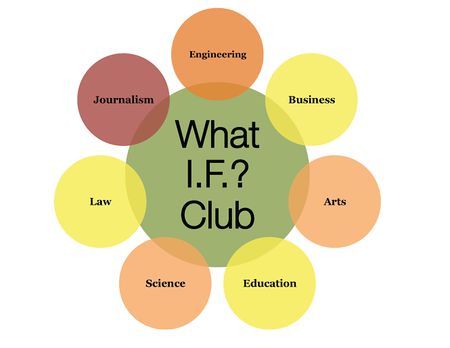Resource:How to set up and teach a class as a student
Contents
Introduction
The What I.F.? club (I.F. stands for Innovation Fellows) was created to further design thinking and lean start-up techniques through workshops, speakers, and projects that promote innovation and entrepreneurial thinking. This club is located on the University of Georgia’s (UGA) main campus in Athens, GA, and is entirely student-driven.
Need and Goal
Gregory Wilson, the founder of the club What I.F.? , saw a need for innovation and entrepreneurial enrichment upon evaluation of the UGA campus by completing the University Innovation Fellow's Landscape Analysis during training. Gregory found that current campus organizations were either too focused on entrepreneurship or not facilitated across disciplines - a characteristic of innovation that cannot be denied. Research has shown that diversity breeds innovation.
Gregory assessed the interest of students after standing as a guest lecturer to a freshman mechanical engineering class. He believed that he could get engineers excited about design thinking through inter-disciplinary groups. To get started building a club of this sort on your campus, complete the following:
- Identify your need
- Ask yourself: Why is this class/club needed? How are you going to solve that need?
- Hold focus group sessions, attend classes, go to other organization meetings - get to know the audience you are hoping to reach
- Establish goals for yourself, your club, your audience
- Ask yourself: What do you hope to gain from this experience? What do you hope your audience gains from this experience?
- Generate a mission statement
- Ask yourself: Why are you creating this club?
- This statement should be no longer than 3-4 sentences and should be attention-grabbing. It should establish your passion, identify your goals and present a direction for your club. Much like starting a company, your club must consist of these components to build a foundation.
Create a New Class or Academic Offering
For a lesson in “How to set-up and teach a new class or academic offering”, you will be taken through the development of a new on-campus organization. Discussed below are some pointers and checklist items that should be considered for each step, and then it will be applied to the club of interest.
Gregory Wilson, a second year PhD student at the University of Georgia and current University Innovation Fellow, was interviewed for his experience in founding an innovation and design club known as the What I.F.? club.
Topic
What is unique about the club What I.F.? It is not department or discipline specific. As is depicted in the logo, a variety of disciplines are involved, including but not limited to engineering, journalism, law, science, education, arts and business. You need to be able to create a topic engaging very different educational backgrounds. Make sure to:
- Determine the expertise of your audience
- Ask yourself: Is this club meant to foster a specific area or skill between like-minded individuals? Or is it meant to bring together diverse groups of individuals for a greater cause?
Location
Currently, the location for our bi-weekly meetings is the campus engineering auditorium because of the ease of access. However, steps are being taken to offer a more central meeting location to further promote the idea of interdisciplinary work. A potential site for future meetings being considered is the campus student center.
Academic Permission
Before starting a student organization, the Center for Student Organizations is the location where all regulations and requirements can be attended to at mandatory meetings. Because What I.F.? was just started in September 2013, they must wait until the start of the next semester to become an official student organization. At that point, they will have free access to resources provided by the Center for Student Organizations. In acquiring acadmic support, recognize the following:
- Understand the limitations, risks, and opportunities associated with the focus of your organization
- Ask yourself: Where do I go from here? Are there requirements I have to fulfill before I can proceed? Where can I find help in answering these and other questions?
- Identify a central source for reference and help
- Seek out other organization leaders and ask questions
Support
What I.F.? is an entirely student-driven club. The only faculty support has been from the mechanical engineering professor whose freshmen class was spoken to in order to gage the general interest for the club. This faculty support, under the general clearance of the department and college, has allowed the club to proceed with meetings until it is officially awarded status as a registered student organization. When starting out on this endeavour:
- Know that you cannot do this on your own - you may think you are the smartest person in the world, but even the smartest people in the world oftentimes can’t accomplish a project of this caliber by themselves.
- Ask yourself: Who has done this before? Who would be good partners to advance this cause?
Cost
No funds supported the creation of the club. All costs have been covered by already present resources, or provided by the club creator himself. One idea for creating funds for the club is possiblity of implementing a fee charged for membership. Other future endeavors will include applying to educational grants and hosting fundraisers. These fundraisers will not only generate revenue for the club’s spending, but will also generate greater awareness of the club’s existence and participation in the community. When building a club:
- Know that everything costs money.
- Ask yourself: Where can I go to generate interest about this club? Who would be willing to donate to this cause?
- Take into consideration adjacent groups to your audience and include them.
Faculty, Teachers and Mentors
Other than initial faculty support to generate club interest, the club has to be driven by student involvement. Gregory is looking to round out his executive board this semester to balance responsibility. The club's constitution and by-laws must be generated before the end of the semester.
An outside mentor is scheduled to come speak at a future club meeting. A community accelerator and technology incubator, Four Athens, will be leading a technology talk that focuses on the growing start-up scene located in Athens, GA. This will expose students to some of the opportunities available for innovations that they create. Understand the following when searching for campus champions:
- You will need help along the way.
- Ask yourself: Who do I currently have in my network that would be willing to help? Is there someone I need to seek out who might be outside my network?
- From the start, seek out enthusiastic mentors who want to see you and your organization succeed. No matter if they are or are not already in your network, bring them in on your project.
Audience
An additional facet that makes this club unique is it is not grade specific. Currently, Gregory is promoting his club to new freshmen, but he has had interest from all levels. Cross-disciplinary projects cannot be limited by grade or skill-level. Instead, the best teams identify each team member’s weaknesses and strive to fulfill those weaknesses as a unit. Oftentimes this is achieved through additional team members from different disciplines with alternative backgrounds. It is this notion that strong innovative teams are interdisciplinary, which is the foundation for the What I.F.? club. Define your target audience early, so you can begin to identify potential student members:
- Identification of your market audience is critical
- Ask yourself: If I were in their shoes, what would I want to see out of a club that I would be willing to join? Where should I focus my attention first? Who will listen?
Timeline
Gregory was named a University Innovation Fellow in May 2013, when he generated a Landscape Analysis of his University of Georgia campus. In the spring, he obtained initial interest from four main people, but once the summer began, the interest diminished until fall 2013. Gregory attended a class the second week of the semester to introduce the idea for the club, and noticed a large majority were interested. The first few meetings were held in early September. The timeline for this individual club, from idea to implementation, was four months (May to September). In preparing a timeline, be realistic and know:
- It takes time to find the recipe for success.
- Ask yourself: What is the one device you cannot live without? The process of original idea concept generation to physical development and eventual commercialization takes time - and lots of it.
- Be patient.
- Things always take twice as long as you originally expect them to. Be prepared for this delay and don’t get discouraged.
Lessons Learned and Tips for Others
- Getting off the ground is the hardest part. But if you collaborate with other groups and attend other group meetings, you see the inner-workings of an organization. All organizations are run slightly different. Absorb any/all information and decide from there what you like and dislike.
- Make your club generation a student-level initiative. Gregory first relied on professors to talk about the club and pass out flyers to their students. It wasn’t until Gregory took the initiative to go talk with the students themselves and self-proclaim the goodness of the club that he started getting an overwhelming response.
- Be patient. Building an organization will take lots of hard work. Oftentimes, faculty, regulations and requirements may seem like roadblocks, but it will make your organization stronger and healthier to have completed things correctly from the beginning.
- Pick your team and organization board wisely. You will be spending lots of time together.
- Have fun! This is something not everyone gets to do. Be an entrepreneur. Be an innovator. Change the world, but start by changing your campus.

